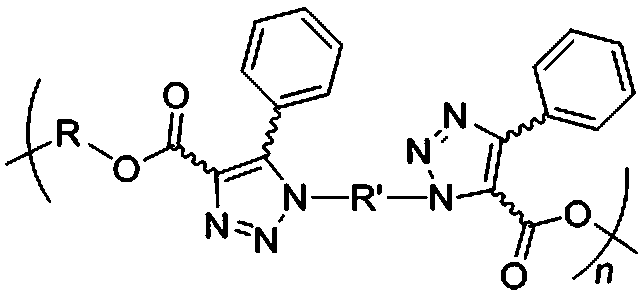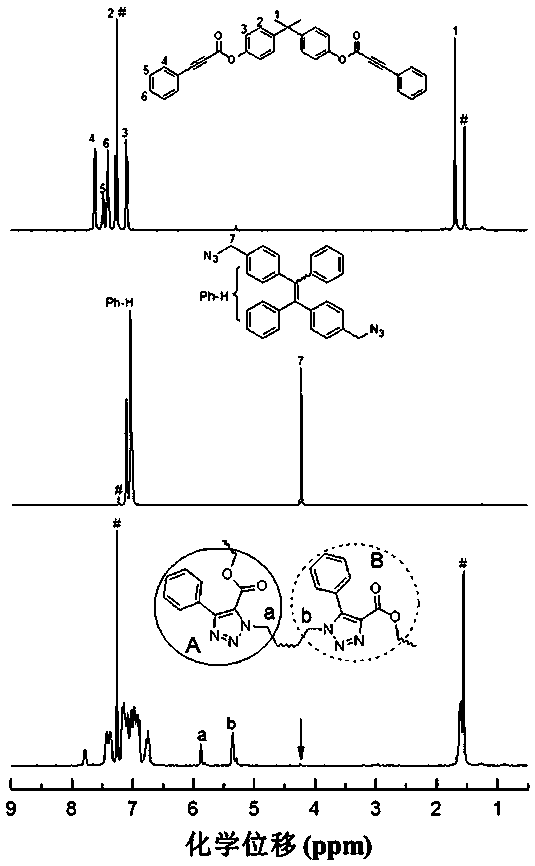A kind of polyphenyltriazole formate and its preparation method and application
A technology of polyphenyltriazole formate and phenylpropiolic acid dibasic ester, which is applied in the fields of polymer chemistry and material science, can solve the problem of cytotoxicity affecting the photoelectric properties of polymers, polytriazole with poor solubility and difficult to remove. and other issues, to achieve the effects of wide substrate applicability, good functional group compatibility, and prevention of explosive attacks
- Summary
- Abstract
- Description
- Claims
- Application Information
AI Technical Summary
Problems solved by technology
Method used
Image
Examples
Embodiment 1
[0039]
[0040] Add 1.14 g (5 mmol) bisphenol A, 3.10 g (15 mmol) DCC, 0.244 g (2 mmol) DMAP, 0.38 g (2 mmol) TsOH to a 250 mL two-necked flask, and vacuum and fill with nitrogen three times. Add 100 mL of dichloromethane and stir to dissolve, then dissolve 1.61 g (11 mmol) of phenylpropynic acid in 20 mL of dichloromethane in an ice-water bath, and add it dropwise to the reaction system through a constant pressure dropping funnel. The reaction was stirred overnight at room temperature, filtered, washed with dichloromethane, and the filtrate was spin-dried to obtain a crude product, which was separated and purified by column chromatography and dried to constant weight in vacuo to obtain 1.89 g of white solid (yield: 78.1%) ), is the first monomer phenylpropynoic acid dibasic ester monomer. 1 H NMR (400 MHz, DMSO- d 6 ), δ (TMS, ppm): 7.71 (d, J = 7.4 Hz, 4H), 7.62 (t, J = 7.4 Hz, 2H), 7.52 (t, J =7.5 Hz, 4H), 7.33 (d, J = 8.6 Hz, 4H), 7.21 (d, J = 8.6 Hz, 4H), 1.68 (s, 6H)...
Embodiment 2
[0048] The phenylpropynoic acid dibasic ester monomer and the binary organic azide monomer are the same as in Example 1. Add 48.4 mg (0.1 mmol) of the first monomer and 44.2 mg (0.1 mmol) of the second monomer to a 10 mL polymerization tube, vacuum and fill the system with nitrogen, repeat three times, and then add 0.2 mL of dry DMF. After the body is completely dissolved, react at 150°C for 1 hour, cool to room temperature and dilute with 5 mL of chloroform, and add the solution dropwise to 200 mL of vigorously stirred n-hexane through a cotton-plugged dropper, let stand and filter After drying to constant weight, the polymer was obtained with a yield of 85.1%. GPC results show: M w = 10100, PDI =1.4. The polymer also has good solubility and thermal stability; because it contains tetraphenyl vinyl groups with aggregation-inducing luminescence activity, the polymer also has aggregation-inducing luminescence properties and can be used for the detection of explosives, as in Ex...
Embodiment 3
[0050] The phenylpropynoic acid dibasic ester monomer and the binary organic azide monomer are the same as in Example 1. Add 48.4 mg (0.1 mmol) of the first monomer and 44.2 mg (0.1 mmol) of the second monomer to a 10 mL polymerization tube, vacuum and fill the system with nitrogen, repeat three times, and then add 0.2 mL of dry DMF. After the body is completely dissolved, react at 150°C for 4 hours. After cooling to room temperature, dilute with 5 mL of chloroform, and add the solution dropwise to 200 mL of vigorously stirred n-hexane through a cotton-plugged dropper, let stand and filter After drying to constant weight, the polymer was obtained with a yield of 78.3%. GPC results show: M w = 24800, PDI =1.8. The polymer also has good solubility and thermal stability; because it contains tetraphenyl vinyl groups with aggregation-inducing luminescence activity, the polymer also has aggregation-inducing luminescence properties and can be used for the detection of explosives, a...
PUM
| Property | Measurement | Unit |
|---|---|---|
| molecular weight distribution | aaaaa | aaaaa |
Abstract
Description
Claims
Application Information
 Login to View More
Login to View More - R&D
- Intellectual Property
- Life Sciences
- Materials
- Tech Scout
- Unparalleled Data Quality
- Higher Quality Content
- 60% Fewer Hallucinations
Browse by: Latest US Patents, China's latest patents, Technical Efficacy Thesaurus, Application Domain, Technology Topic, Popular Technical Reports.
© 2025 PatSnap. All rights reserved.Legal|Privacy policy|Modern Slavery Act Transparency Statement|Sitemap|About US| Contact US: help@patsnap.com



